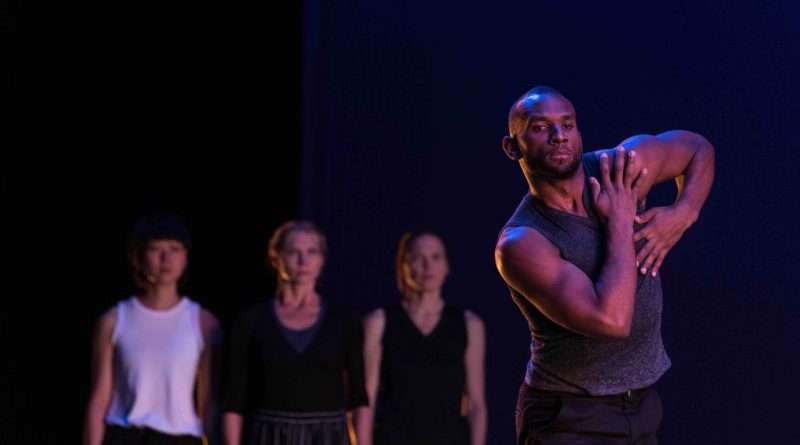INTERVIEW: Choreographer Tiffany Mills on ‘Not then, not yet’
Photo: Tiffany Mills Company — featuring, from left, Mei Yamanaka, Emily Pope, Mills and Nikolas Owens — will perform Not then, not yet at The Flea Theater in New York City. Photo courtesy of Susan Allen / Provided by press rep with permission.
Celebrated choreographer and dancer Tiffany Mills is interested in exploring the nebulous area between endings and beginnings in her new work titled Not then, not yet, which is set to play New York City’s Flea Theater Nov. 13-16. The piece is set to music by Angélica Negrón and Muriel Louveau.
Mills founded her dance company in 2000, and over the years she has brought the performers to La MaMa, the Brooklyn Academy of Music, the Guggenheim Museum and The Duke on 42nd Street, among other locations around the globe.
For the world premiere of Not then, not yet, the choreographer was inspired to explore the liminal space between endings and beginnings thanks to the early works of author Mary Shelley, who explored creation and destruction, integration and isolation. This early inspiration, along with Negrón and Louveau’s music, led to Not then, not yet, which is centered on movement and music, and the dancers’ investigation of past/future, young/old, life/death.
Recently Hollywood Soapbox exchanged emails with Mills about the new piece. Questions and answers have been slightly edited for style.
How important is the music of Angélica Negrón and Muriel Louveau to this piece?
The music is absolutely essential in Not then, not yet. I have been working with Angélica Negrón and Muriel Louveau from the onset of this project. We had multiple discussions around inspiration and concept before working in the studio. When we first started creating material in 2018, we held an intensive in which we generated material together through improvisations, as well as responded to initial musical ideas that Angélica and Muriel created.
Then, as the project progressed, we spent time physically apart (in NYC and Paris), but continued the development of material via Skype sessions. Throughout, we have been open to the evolution of the material, based on the needs and ideas of all collaborators. This type of collaboration is fruitful as it allows for all voices to be heard.
How do you define a ‘state of transition’ between endings and new beginnings?
We have examined many different ‘states of transitions.’ Some are larger and more universal, like the place between sleep/wake, day/night, life/death. Some are smaller and more personal, like the place between a choice and making that choice. When I first started the project, I made an assumption that states of transition were dark, shadowy places of less understanding. However, throughout this project I began to understand that states of transition can be places of discovery and potential — and they’re ubiquitous!
Is this a particularly challenging piece for the performers?
Yes! There are several challenges for the six dancers — myself, Jordan Morley, Kenneth Olguin, Nik Owens, Emily Pope and Mei Yamanaka. In this project, each dancer has a unique role. Some of the roles involve a great amount of personal excavation and travel to dark places to experience a liminal space.
One of the largest challenges is to stay authentic and open throughout the journey, each time it unfolds. For Muriel, who will perform her vocals live, she just arrived from France and faces the challenge of being integrated into the blocking of this work merely one week before its premiere. Another completely separate challenge is working with six folding chairs as props. These chairs have an unpredictable life of their own, which adds uncertainty each time the project is performed.
Is there an extra level of nervousness and/or excitement for a world premiere?
A world premiere is exciting, daunting and always arrives so fast. The last weeks before the show are like riding on a roller coaster — fun, exhilarating, a rush. One grounding element is working with my longtime collaborator Kay Cummings. I love her no-nonsense feedback, her humor and her ability to see potential. She also has a wonderful ability to analyze work on multiple levels.
When you founded this dance company in 2000, what was your original goal? Do you feel like you have achieved it completely, or there’s more work to be done?
I founded Tiffany Mills Company in 2000 to form an infrastructure for my work. It has provided me with stability, sustainability and growth. I wanted to surround myself with a group of dancers, board members and staff who were interested in a long-term investment in the performing arts.
After 19 years, I know this model works. For my company I envisioned performing locally, nationally and internationally. That we have accomplished.
Yet, there is always more work to be done. I am continuously interested in the next project, the talented group of dancers who make up the company and the new array of collaborators from diverse mediums that bring fresh ideas to the work. As I finish one project, I’m also thinking about what’s next and what will spark new inspiration in the studio.
By John Soltes / Publisher / John@HollywoodSoapbox.com
Not then, not yet, presented by Tiffany Mills Company, will play Nov. 13-16 at The Flea Theater in New York City. Click here for more information and tickets.

